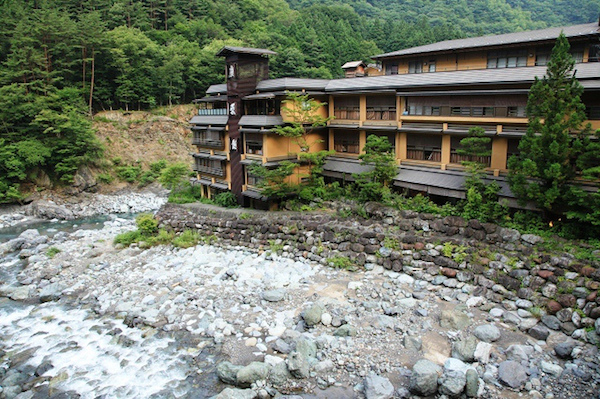
Japanese construction company Kongō Gumi was the world’s oldest continuously operating independent company until it was absorbed as a subsidiary of another larger construction company in 2006.
Headquartered in Osaka, the once family-owned company traces its origins back to 578 AD when one of the engineers Prince Shotoku brought from Baekje to Japan to build the Shitennoji Temple decided to start his own business. A 10-foot, 17th-century scroll traces 40 generations back to the company’s start. As with many distinguished Japanese families, sons-in-law often joined the clan and took the Kongō family name. Thus, through the years, the line has continued through either a son or a daughter.
Unfortunately, nothing can last forever. Kongō Gumi fell on hard times and went into liquidation in January 2006, but the company continues to operate as a wholly owned subsidiary of the Takamatsu Construction Group. It should also be noted that the Kongō family still continues to practice as Miya Daiku (carpenters). (Source | Photo)

In 705 AD, the natural hot springs surrounding Nishiyama Onsen Keiunkan allowed for the creation of a number of healing baths that drew visitors to come to the hotel and relax. Among its early patrons were Samurai and Shogun. 52 different generations of descendants have cared for and operated the inn, growing the space and modernizing it slowly with each passing epoch.
Keiunkan is considerably larger than it was over a thousand years ago, but both the look and feel of the inn have remained unchanged, despite its modern amenities. (Source | Photo)

The St. Peter Stiftskeller is mentioned in a document by the scholar Alcuin, a follower of Charlemagne, in the year 803 AD. The Salzburg establishment claims to be the oldest documented restaurant in continuous operation.
The Stiftskeller, located in St. Peter’s Archabbey, was at one time indistinguishable from a monk’s pub. Not only is it the oldest restaurant, but it’s also the seventh-oldest company in the world and the oldest company outside of Japan. (Source | Photo)

Sean’s Bar, a pub in Athlone, Ireland, dates back to 900 AD.
During renovations in the 1970s, workers found evidence that the already historic pub may have been around longer than anyone had previously thought. It was discovered that one of the walls was made of wattle and daub, an ancient building compound that used wooden strips held together by mud and clay. They also found some coins that dated back to around 900 AD, which was confirmed when the wall was carbon tested.
It is believed the bar was established as an inn for travelers crossing the fjords that were once in the area.
Sean’s holds records of every owner since its inception, including Boy George, who was a proprietor back in 1987. (Source)

No one’s quite sure when the winemakers at Château de Goulaine started bottling wine, but by most accounts it appears to have been around the year 1000 AD.
Château de Goulaine is more than just a winery — it is a historic castle that was rebuilt in the 12th century and again in the 16th. The Goulaine family is prominent in French history — its members served in the Crusades and other in religious wars following the Catholic-Protestant split during the Reformation. The castle has been home to the same family for over a thousand years, and wine is still being produced here. The castle is also a museum, and houses numerous works of art. (Source | Photo)

Agnone, a village in Molise, Italy is known as the “town of the bells.” The Pontifical Marinelli Foundry is located here and has been in business for 700 years. In the ancient forge, bells and bronze sculptures are made entirely by hand, using the same lost-wax casting technique dating back to Medieval and Renaissance times. The bells made here can be seen in some of the most prestigious churches in the world, as well as in the Giovanni Paolo II Historical Museum of the Bell, which is adjacent to the forge.
In 1924, Pontifical Marinelli was awarded “the title of pontifical foundry” by The Vatican. The Roman Catholic Church now accounts for 90 percent of all orders placed. The company is co-owned and operated by brothers Armando and Pasquale Marinelli, who produce up to 50 bells a year and currently employ 12 people. (Source | Photo)

Rathborne Candles, based in the Dublin suburb of Blanchardstown, was founded in 1488 — four years before Columbus discovered America. It has survived everything from plagues to the coming of electricity, and the Second Vatican Council.
During the 19th Century, Rathborne held the contract for all the street lighting fittings in Dublin. When electricity became the norm, the company refocused its efforts on church candles. However, the Second Vatican Council decreed that Catholic churches should be stripped of much of their previous ornamentation including elaborate candles. But, as Rathborne’s financial director Vincent Brady says, “the meddling ecclesiastical busybodies relented and the traditional church candle survived.”
While the company is no longer in the hands of the Rathborne family (they have all since died out), the last direct descendant has an open invite to visit at any time.
The company has big plans for the future and is determined to be around another 500 years. Says Brady, “We would like to set up a museum where we could exhibit all the old machines and demonstrate the ancient candle-making skills, and maybe one day return to East Wall, which is our ancestral home.” (Source | Photo)

During the Middle Ages, Gardone, Italy was a mecca for iron working. At the beginning of the Renaissance Era, the city was known for its high-quality gun making.
Maestro Bartolomeo Beretta was a master gun barrel maker living in Gardone. In 1526, the Arsenal of Venice paid him to make 185 arquebus barrels, making the Beretta company the oldest manufacturing company in the world. The Beretta family has continuously controlled the company for its entire history. Ugo Gussalli Beretta and his two sons, Pietro and Franco, still maintain leadership of Beretta today. (Source |Photo)

While the U.S. is a relatively new nation, its oldest business predates its existence. The Shirley Plantation is an estate located on the north bank of the James River in Charles City County, Virginia. It is the oldest family-owned business in North America, dating back to 1613 with operations starting in 1638. The mansion, referred to as the “Great House,” is largely in its original state and is owned, operated, and resided in by direct descendants of Edward Hill I. Today, Shirley continues to be a working plantation, a private family home, an event destination, and a National Historic Landmark. (Source)

The Post och Inrikes Tidningar was founded in 1645 by Queen Christina and was a staple for Swedish news junkies throughout the late 17th and 18th centuries. In its storied history, PoIT published international and domestic news coverage, weather observations, poetry and serialized novels.
As the number of newspapers multiplied, PoIT reduced its news content, and, by the early 1900s, was no longer the newspaper of reference in Sweden. Instead, it became the country’s official notification medium for announcements like bankruptcy declarations or auctions. In 1978, the paper adopted the booklet format, but readership continued to decline. The final print version had a circulation of only 1,500 and on January 1, 2007, it switched over to an Internet-only format.
Hans Holm, who served as the chief editor of the paper for 20 years, said, “We think it’s a cultural disaster. It is sad when you have worked with it for so long, and it has been around for so long.” (Source | Photo)
Source: Oddee.com
This post has already been read 64446 times!
















